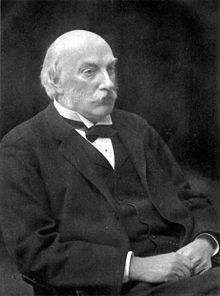John William Strutt, 3rd Baron Rayleigh
Lord Rayleigh | |
|---|---|
 John William Strutt, 3rd Baron Rayleigh | |
| Born | 12 November 1842 |
| Died | Template:Euro death date and age |
| Nationality | |
| Alma mater | University of Cambridge |
| Known for | Discovery of argon Rayleigh waves Rayleigh scattering Rayleigh criterion |
| Awards | File:Nobel.svg Nobel Prize for Physics (1904) |
| Scientific career | |
| Fields | Physicist |
| Institutions | University of Cambridge |
| Doctoral advisor | Edward John Routh |
| Doctoral students | J. J. Thomson File:Nobel.svg George Paget Thomson File:Nobel.svg Jagdish Chandra Bose |
John William Strutt, 3rd Baron Rayleigh (12 November 1842 – 30 June 1919) was an English physicist who (with William Ramsay) discovered the element argon, an achievement that earned him the Nobel Prize for Physics in 1904. He also discovered the phenomenon now called Rayleigh scattering and predicted the existence of the surface waves now known as Rayleigh waves.
Biography
Strutt was born in Langford Grove, Essex and in his early years suffered frailty and poor health.
He went to Harrow School and began studying mathematics at Trinity College, Cambridge, in 1861. In 1865, he obtained his BA (Senior Wrangler and 1st Smith's prize) and MA in 1868. He was subsequently elected to a Fellowship of Trinity. He held the post until his marriage to Evelyn Balfour, daughter of James Maitland Balfour in 1871. He had three sons with her.

In 1873 his father, John Strutt, 2nd Baron Rayleigh died, and he inherited the Barony of Rayleigh.
He was the second Cavendish Professor of Physics at the University of Cambridge, following James Clerk Maxwell in this position from 1879 to 1884.
Approximately 1900 Lord Rayleigh developed the Duplex (combination of two) Theory (Human sound localization using two binaural cues). Interaural time delay (ITD) and interaural level difference (ILD) (assuming a spherical head with no external pinnae). Humans perceive sound objects spatially, using the difference in the phase (time delay) of the sound and the difference in amplitude (level) between the two ears, in a similar way that stereoscopic sight provides depth perception. Also called two primary cues for azimuth (horizontal location) but possibly its two primary cues for a 3 dimensional bearing. For example when you hear a seagull call out you can determine roughly x y and z location of the sound. Although Pinnae reflections are considered a main cue for vertical localisation.
Lord Rayleigh was elected to Fellow of the Royal Society on June 12, 1873 and was elected president of the Royal Society between 1905 and 1908.
Lord Rayleigh died on June 30, 1919 in Witham, Essex.
Craters on Mars and the Moon are named in his honor as well as a type of surface wave known as a Rayleigh wave.
Prizes
- Royal Medal (1882)
- Matteucci Medal (1894)
- Copley Medal (1899)
- Nobel Prize for Physics (1904)
- Rumford Medal (1920)
See also
- Rayleigh criterion
- Rayleigh fading
- Rayleigh number
- Rayleigh quotient
- Rayleigh scattering
- Rayleigh (unit) (named after his son)
- Rayleigh waves
- Rayleigh-Jeans law
- Rayleigh distribution
- Rayleigh-Taylor instability
- Rayleigh Medal
Notes
References and further reading
- British physicists
- Discoverers of chemical elements
- Nobel laureates in Physics
- Presidents of the Royal Society
- Chancellors of the University of Cambridge
- Members of the Order of Merit
- Alumni of Trinity College, Cambridge
- Old Etonians
- Barons in the Peerage of the United Kingdom
- Fellows of the Royal Society
- Tripos Wranglers
- 1842 births
- 1919 deaths
